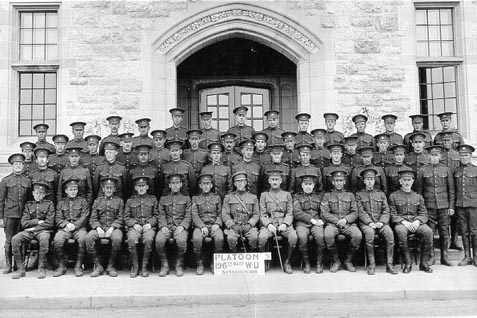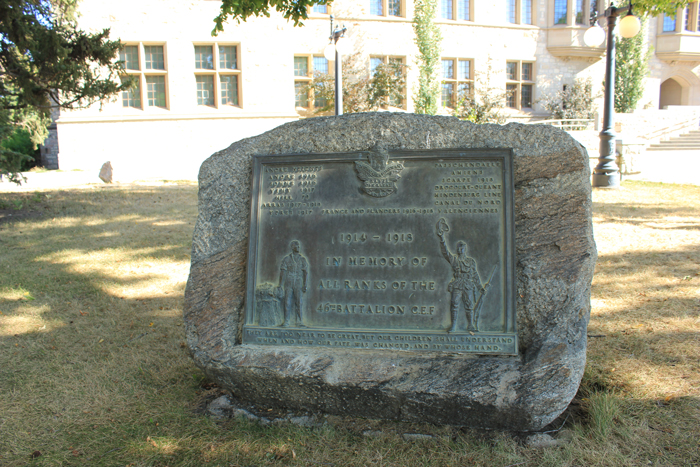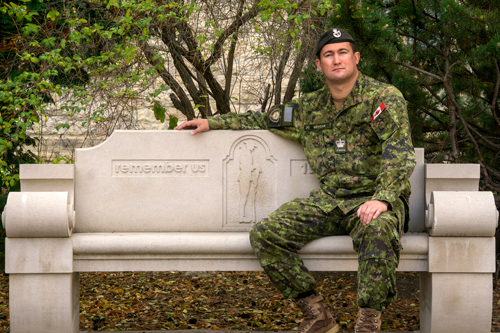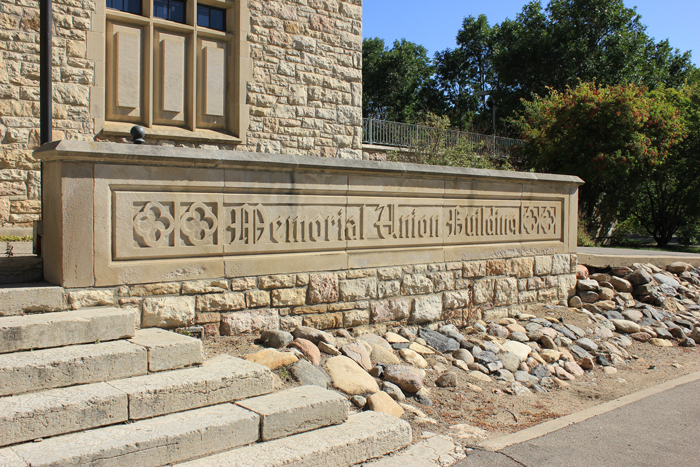
We remember
The University of Saskatchewan’s war memorials are a daily reminder of our campus connection to Canadian veterans.
By Leslie-Ann Schlosser with files from University of Saskatchewan Archives and Special Collections.The World Wars that inflicted the country at the beginning of the 20th century had an immense impact on the University of Saskatchewan (USask) campus.
During the First World War (WWI), of the 345 USask students, faculty and staff who enlisted in the war effort overseas, 69 didn’t come home. More than 100 more were wounded and 33 were awarded medals of valour. The College of Engineering closed its doors from 1916-1917 when the majority of faculty and students enlisted.
The role of universities somewhat shifted when the Second World War (WWII) began in 1939. Students were viewed not only for recruiting purposes, but for their academic potential. Instead of draining the campus of young men, the Government of Canada encouraged students taking courses in “sciences, engineering, medicine or agriculture to remain at the universities until they had completed their academic preparation.”
Educated men were in high demand, but so were men with military training. It was mandatory that those attending classes be prepared for military service and had to complete military training.
The end of WWII brought optimism and a glimmer of hope to campus. Student enrolment between 1945 and 1946 exploded, with veterans returning home looking to become university graduates. In the fall of 1944 enrolment was 1,530 and by 1946 it was 4,195.
Today, several memorials are sprinkled throughout the beautiful USask campus, commemorating the brave men and women who walked the halls of our university but also walked the fields of Vimy Ridge, Passchendaele and many other war zones.
Each memorial tells a unique and special story. Their presence is a way of remembering the thousands of Canadians who gave up their lives so we could have one:
Ribbons in the corridors
During WWI, the USask Board of Governors made the decision to honour the university community and create a roll of honour which would display students, faculty and staff who enlisted in the war. This roll of honour would be painted around the corridor of the College Building, which has been renamed the Peter MacKinnon building.
These ribbons were part of the original building design with 349 names of veterans inscribed on the walls, including some that were added following research more than 85 years later. About three-quarters of these veterans were USask students when they enlisted; the others were graduates, former students, faculty, and staff. Names of the volunteer nurses who treated patients during the 1918 influenza epidemic are also inscribed on the walls.
The ribbons remain a prominent piece in the Peter MacKinnon building today.

Memorial Gates
The Memorial Gates, while no longer marking the entrance into USask, remain a prominent memorial for the 69 students and faculty who died in WWI.
The memorial consists of two main gates, one on either side, originally designed for traffic and two small gates for pedestrians.
Erected in 1927-28, the gates and tablet were unveiled by then USask president W.C. Murray. USask Remembrance Day services have been held annually at the gates.

Memorial Stone
A memorial stone and plaque honouring the memory of those who served with the 46th Canadian Infantry Battalion (South Saskatchewan), Canadian Expeditionary Force, 1914-1918, sits under a tree on the northeast corner of the Bowl.
Formed in February of 1915, the 46th battalion was filled primarily with Saskatchewan youths, many via USask. Also known as the "suicide battalion,” it fought in some of the bloodiest encounters of the war. Of the 5,374 men in the 46th battalion, 4,917 were either killed or wounded. A particularly costly battle was Passchendaele, where there were 403 casualties from the battalion's strength of 600 men.
With the end of the war came demobilization and the end of 46th battalion. The soldiers became veterans and returned to civilian life. Many re-enrolled or entered the university for the first time. Many others did not return.

War Memorial Bench
USask’s Great War Commemoration Committee unveiled a new memorial bench on campus in 2018 to mark 100 years since the end of WWI.
The bench dedication ceremony was the culmination of four years of work by the committee to honour the students, staff and faculty members from USask who served in the WWI.
“We wanted to mark the 100th anniversary of the end of First World War with a permanent monument—simple, graceful and respectful—dedicated to the men and women of the campus who served their country from 1914 to 1918,” said professor emeritus of history and committee chair Bill Waiser, in a 2018 On Campus News article.
The bench is located in the plaza located between the two original campus residences, just south of The Bowl and immediately north of the Memorial Union Building.

Memorial Union Building
The Memorial Union Building, or MUB, as it became known, was designed to serve as a memorial to the students, faculty and staff of USask who perished overseas in WWI and WWII.
During the 1945-46 academic year, a Students’ Union Building Committee was formed. The committee outlined proposals for the new building, which included an auditorium, a ballroom, lounge rooms, a tuck shop and student offices. In addition to university funding, the University of Saskatchewan Student’s Union (USSU) launched the Memorial Union Building Fund, which solicited donations from alumni worldwide, as well as a number of local and national businesses in order see the project come to fruition.
The MUB formally opened on Nov. 11, 1955. It was used primarily for student functions including dancing, card-playing, chess, and studying, though it never became the hub of student activities it was originally intended to be.
Still, the building remains today a centre of social life on campus, serving as home to the offices of various student societies, Louis’ pub, and a coffee shop.



